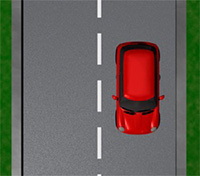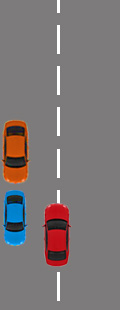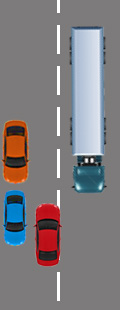Meeting Traffic Tutorial
Giving Way
If an obstruction is on your side of the road, you should stop and give way to oncoming traffic. If the right of way is yours, never take for granted that an oncoming vehicle will stop and give way. Always be prepared to stop and give way.

Road narrows on both sides

Road narrows on right (left if symbol reversed)

You have priority over oncoming vehicles

Give way to vehicles from other direction
Your Driving Road Position
In normal driving conditions, you should position your car in the centre of the lane you are driving in. Avoid driving too close to the kerb unless you need to make space for oncoming traffic.

Passing Parked Vehicles
When passing a parked vehicle, you should always try and leave a space of at least the width of an average car door. This is to safeguard against a vehicle unexpectedly pulling out or a car door suddenly opening.
Creating this space will also help you see children moving out from between parked cars to cross the road. If such space can’t be created, and you are forced to pass closer to the parked vehicles, then reduce your speed and be ready to stop.
The less clearance you can give, the slower you need to drive. In the first image below, it would be safe for the red car to pass the two parked cars at 30 mph. In the second image, however, where there is less clearance, 15-20 mph would be safer.


Following Traffic
The key questions you should ask yourself when following traffic is:
if the car I’m following suddenly hits the brakes, have I enough space to react and brake to a safe stop?
If the answer is no, you need to slow down and pull back to create a safe gap. On a day when the road is dry, you can use the two-second rule to show you what a safe gap is. As the vehicle in front passes an object, such as a signpost, begin counting. If you reach the same object in less than two seconds, you are too close to the vehicle in front. A safe time is two or more seconds.
If the road is wet, the two-second rule becomes the four-second rule as stopping times double in the wet. In icy conditions stopping distance distances are ten times longer.
Following Large Vehicles
When following a large vehicle such as a lorry or coach, you should leave extra space between you and it. If you get too close, your view past it will be limited, and you won’t have a clear view of what’s happening ahead, which can make overtaking the vehicle dangerous.
The driver of the large vehicle may also find it difficult to see you in their side mirrors. Keeping well back will also protect your windscreen from any spray the large vehicle throws up.
Tailgating
Tailgating is following another vehicle too closely. In the image below, the red car is tailgating the blue car.
Tailgating is dangerous because if a tailgated car had to stop suddenly, it is likely the tailgating vehicle would crash into the back of the car.
Tailgating breaks the two-second rule.
If you find yourself being tailgated try not to feel intimidated.
For your safety, slow down and increase the gap between you and any vehicle in front, so if the vehicle in front slows suddenly, you will have plenty of time to react, decreasing the chance of the tailgater crashing into you. It also gives more opportunity for the tailgater to overtake you, thus ridding yourself of the problem.

Driving In Traffic Jams
When in slow-moving traffic the first rule is, never obstruct an exit or junction, even a left turn. Hold back until the traffic ahead has moved forward far enough for you to clear any exit or junction. When the traffic stops it is always wise to leave a space of 2 to 3 metres between you and the car in front. This way, if the vehicle in front stalls or breaks down you will have enough space to safely manoeuvre past.
You should keep a reasonable distance between you and the vehicle in front. Use the Tarmac and Tyres Rule: you should stop at a point when you can still see the tyres of the vehicle in front touching the road, plus about 1 metre of tarmac.
